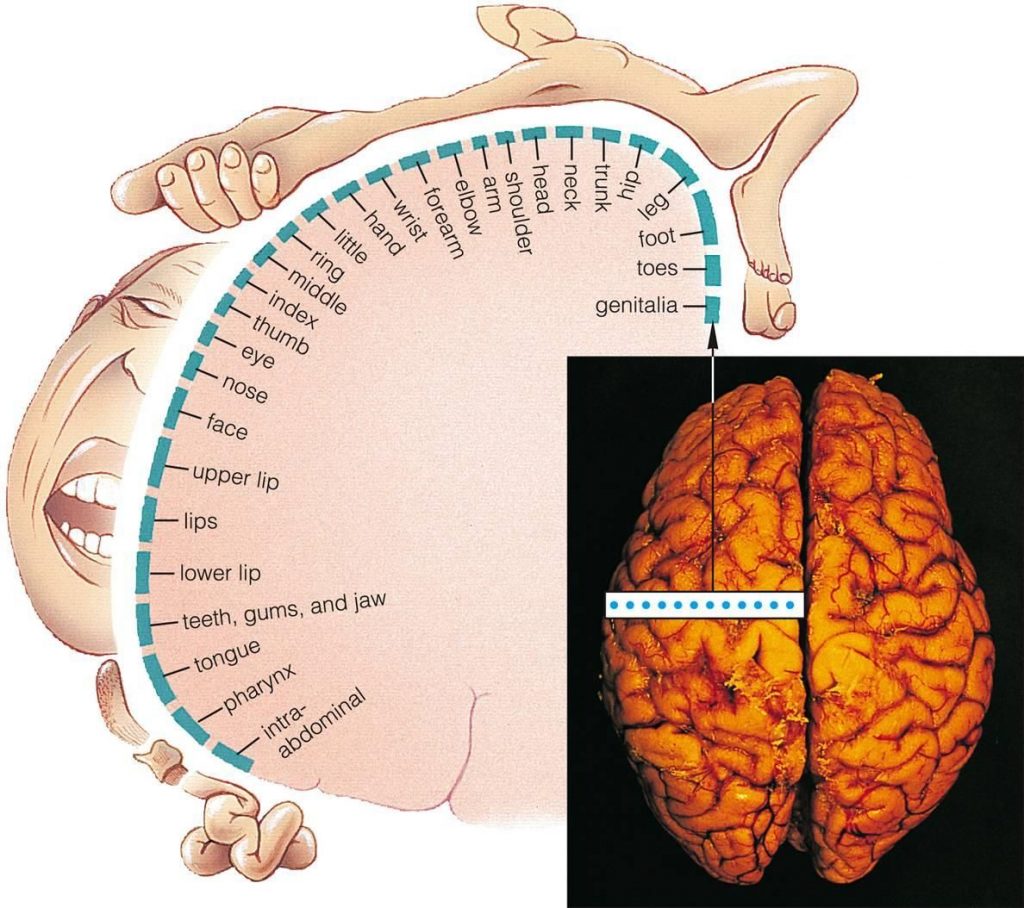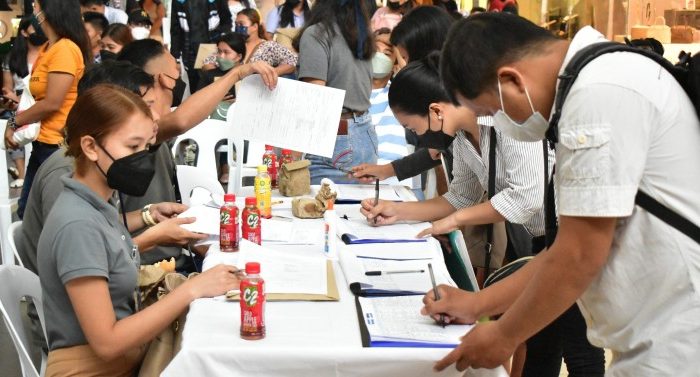The somatosensory cortex is where all the information is processed. The information may come from the mechanoreceptors and the different things that help us with our touch sensation. This sensory information can be touch, temperature, and pain. Firstly, the sensory information that we receive goes and assembles in a place called the postcentral gyrus. So this is the central part of the brain that deals with all the somatosensory information.
Now, if we cut this on either side of it and turn it sideways, we’re able to see something pretty cool take place. The inner side of the brain is very highly organized. We can call this a somatic taupe. Somatic taupey is a map of the body. It is the organization of this sensory cortex so that the information doesn’t get all scrambled up. However, it is very clear that the sensory cortex is laid out in a map fashion. It is not very proportional.

The following image shows that the hip and leg area does not cover much of the cortex. That means that we don’t have a ton of sensation in this area. Whereas our lips pretty much take up the same amount of cortex as the entire hip and upper leg combined. The cortex is laid out like this because it is directly proportional to the amount of sensation or the number of nerves dedicated to that area. So our lips are very, very sensitive as well as our hands.
In this article, we will discuss the structure, location and functions of the somatosensory cortex.
What is the somatosensory cortex?
Definition:
The somatosensory cortex is the central complex part of the brain, responsible for the transportation and processing of sensory information across the body. This part of the brain detects the shape, size, or type of an object. The data of the senses such as touch, temperature, pain, and pressure helps in this process. In addition, the somatosensory cortex helps us realize the position of our body in space. For example, when the brain stimulates the left leg, we will feel sensations in our left leg.
Somatosensory cortex: Anatomy
Before we try to understand the anatomy of the somatosensory cortex, we should first know about the divisions of the somatosensory cortex. It contains two functional parts that are-
- Primary somatosensory area (i.e. cortex S1)
- Secondary somatosensory area (i.e. cortex S2)
Location of the somatosensory cortex
The somatosensory cortex is a part of the forebrain which is present in the parietal lobe.
- The primary cortex (S1) is located on the postcentral gyrus and the posterior part of the paracentral gyrus. It is also attached to the medial front part of the hemisphere.
- The secondary cortex (S2) is present in the fissure. The superior limb of the posterior part of this holds the secondary somatosensory area.
Projection of fibres in somatosensory cortex
● Primary Cortex:
It receives projection fibres from the thalamus. However, it only receives fibres from the ventral posterior lateral and ventral posterior medial nuclei part.
The opposite half of the body provides projection fibres to this cortex. The fibres come in the form of medial, trigeminal and spinal lemnisci.
● Secondary Cortex:
The entire body provides bilateral fibres to the secondary somatosensory area. The neurological link of the secondary cortex is still unknown. For example, the S2 site contains several areas for monkeys, apes, and other mammals, including humans. In other words, biologists assume that the fibres in the secondary location (S2) come from the primary somatosensory area. Well, in humans, the secondary site has parts of Brodmann areas 40 and 43.
As the entire body provides sensations to the somatosensory areas, the representation of all body parts is present. However, the proportion of representation is different based on the number of nerves that are dedicated to that area.
Primary cortex representation:
In the primary somatosensory cortex, the area sets the half of the body as an inverted homunculus. Tongue and lips are represented in the lower part along with the torso, thighs, face, fingers, hands, and arms. However, it sets the lower body area in the posterior part of the paracentral lobule. This also includes anal and genital areas.
Read Also: 9 Circles of Hell | A complete guide to its meaning and punishments
The placement of the cortex in a particular body part depends on the body part’s function rather than the shape or size. Moreover, the representation relies on the presence of the sensory receptors in that particular organ.
Secondary cortex representation:
Firstly and most importantly, the size of the secondary cortex is much smaller than the primary cortex. Also, S2 is less important as a somatosensory cortex rather than the primary somatosensory cortex. The leg portion is present further back, and the face portion is parted in front.
Primary somatosensory cortex: Structure
The primary somatosensory cortex (S1) is located on the postcentral gyrus. Biologists describe the structure of this area in three areas known as Brodmann areas 1, 2, and 3. These three areas craft the primary somatosensory cortex of the brain. When Brodmann cut the brain diagonally, he discovered area 1 first. Later, according to him, from the front part to the posterior, the sequence of the areas are 3, 1, and 2.
Brodmann area
The Brodmann area 3 contains two areas 3a and 3b. On the other hand, Brodmann area 1 covers the tip of the postcentral gyrus. Next, the edge of Brodmann area 3a is in the lower point of the Central sulcus along with Brodmann area 3b, Brodmann area 1, and Brodmann area 2. However, scientists assume the Brodmann area 3b to play the role of the primary somatosensory cortex because,
- The NP nucleus of the thalamus provides opaque inputs.
- Neurons that are present in this area are highly responsive only to somatosensory stimuli rather than other stimuli.
- The electrical stimulations of this area stimulate somatic sensory occurrence.
- Lesions present in this area reduces somatic sensation.
Brodmann area 3 provides opaque inputs in BA1 and BA2. The projection of the Brodmann area from 3b to 1 usually transmits the information of the object. On the other hand, Brodmann area 2 transmits the information of the size and shape of an object. Lesions present in these areas predict an object’s size, shape, and texture, analyzing the information.
Just like another neocortex, the somatosensory cortex contains few layers. According to scientists, our body organizes the layers of the cortex somatotopically. It creates a pattern of a homunculus. In this pattern, the legs and trunk are present in the midline, folding over. The arms and hands are present in the middle of the area, and the face is near the bottom of the figure. As a large number of neurons are present in the lips and hands, the homunculus shows them enlarged.
Functions of somatosensory cortex
Primary cortex (S1)
Primary cortex processes sensations from our body.
The sensory receptors that are located all over the body receive these sensations. These receptors are responsible for detecting the sensations such as touch, pain, temperature, and position of our body.
- The Brodmann area receives most of the somatosensory sensations from the thalamus. It controls the initial processing of information in that particular organ.
- Now, Brodmann area 3b processes the basic information of touch sensations. Meanwhile, area 3a responds to the transmitted information of receptors. BA 3b is connected to BA 1 and BA2, where more complex processing of information takes place.
- Most importantly, the BA 1 plays the primary role in sensing the texture of an object. However, in perceiving the shape and size of an object, BA 2 plays the most important role, along with the involvement in proprioception.
- The primary somatosensory cortex can detect the exact location of the place where the sensation arises in the body. It let us know the exact point of the touch, pain and pressure instantly.
- Firstly, this organ can also detect pressure. Another ability of this region is that it can help in the determination of the weight of an object by looking at it. This helps us assume if we can carry something and how much extra effort is required to carry it. Similarly, the primary cortex helps us to identify any object when our eyes are closed.
Secondary cortex (S2)
First of all, we still don’t have clear information about this region. According to scientists, there is not much connection between S1 and S2. The primary somatosensory cortex provides fibres to this organ. However, the secondary somatosensory cortex can collect information from the surroundings. It assists the brain make decisions on how to deal with this information based on past experiences.
Importance of somatosensory cortex in the human body
As already mentioned above, the somatosensory cortices play an important role in the overall sensational events. They help determine sensations & the exact location of that. The S2 also helps in the reaction according to the sensation. Without these cortices, we would not be able to determine or feel the touch, heat or burn. That could cause unwanted injuries or damage to tissue. Damage in somatosensory cortices may cause paresthesia. It is a disease where we feel numbness, a tickling sensation in a few parts of our body. Any structural or functional changes in these cortices may cause mental disorders, major depression, bipolar disorder, post-traumatic stress disorder, anxiety and panic disorders.
Somatosensory Cortex Damage
Disorders
Damage of this cortex may cause various disorders based on the location & type of injury. Symptoms of a few diseases are mentioned below.
- Defective Localization
In this case, the patient can feel the sensation of touch, heat or pressure, but they can not detect the exact location of the sensation. This can happen due to the damage of lesions in the sensory cortex.
- Loss of Proprioception
The ability that helps us understand the surroundings or the space where we are standing is called proprioception. This is why we can walk continuously without even looking at our feet or paying too much attention. As an example, while closing our eyes, we can even say whether our hands are moving or not. In this case, when we lose the ability to detect our position in a space, it becomes a loss of proprioception. Now, this can occur because of the damage to the sensory cortex. Patients suffering from this disorder can face difficulties in walking, balancing and reaching a certain distance.
- Agraphesthesia
In this case, the patient can feel the sensation of touch and also the exact location of it. But they can not understand the type of the object. For example, if the patient’s eye is closed and we are drawing a letter on their palm, they will not be able to understand the letter.
- Numbness
Damage in the sensory cortex can produce numbness. It can cause a tingling or prickling sensation in certain body parts due to this disorder.
As our lips and face cover most of the sensory cortex, they are vulnerable to numbness.
Treatment of somatosensory cortex disorders
Though damage in the somatosensory cortex may cause significant disorders still we can get rid of it. There are two ways to get rid of this kind of disorder. One is through medication, and the other is through daily therapies.
The best way to recover from this disorder is through sensory reduction exercises.
Few effective therapies may help one like,
- Tabletop touch therapy
- Sensory locating
- Temperature differentiation
- Texture handling
There are also a few proprioceptive Training that may help us maintain an excellent sensory system, such as,
- Balance exercises
- Weight-bearing exercises
- Passive movement training
- Electrical stimulation
- Acupuncture
- Vibration
FAQs
Q. Where is the somatosensory cortex placed?
Ans. It is located in the parietal lobe.
Q. What is the primary function of the somatosensory cortex?
Ans. Receiving and processing the input sensations is the primary function of this cortex.
Q. Is the somatosensory cortex involved in speech?
Ans. The sensory cortex plays an essential role in the muscle movement of the face and the vocal tract. That is why the sensory cortex is also a part of the perception of speech.
Q. What is the taste cortex?
Ans. The primary gustatory cortex is called the taste cortex, as it helps to sense taste.




